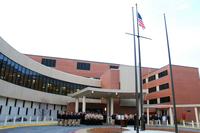The U.S. Air Force is curtailing its media engagements and limiting the amount of information it releases in what it says is an effort to protect operational security, according to a new memo.
The service says its latest move is in line with the new National Defense Strategy, and must "avoid giving insights to our adversaries which could erode our military advantage," according to a seven-page memo obtained by Military.com. The new guidance was first reported Monday by Defense News.
The March 1 memo, titled "Public Affairs Guidance: OPSEC and Public Engagement Reset" highlights for public affairs officers throughout the ranks how to best deal with members of the media. In some specific cases, officers are encouraged to "re-assess" media coverage or stories already in the works.
"PA offices should account for and re-assess all potential media coverage that may result from previous interviews that have yet to be published," the memo says. "The PA office should review all information provided to ensure it protects operational security, and if necessary, work with/advise higher headquarters of the potential coverage."
Media embeds, base visits and interviews are suspended until further notice with limited exceptions.
Related content:
- Flying with the 'Blue Collar Guys' on a C-130 Mission in Iraq
- B-1 Bomber Crews Defend Sniper Pod After Friendly Fire Incident
- Reserve Rescue Aircrews to Air Force: Don't Forget About Us
Combatant commands such as U.S. Air Forces Europe-Africa and Pacific Air Forces are to adhere to their existing media practices, according to the guidance; however, in the likelihood that COCOM-approved engagements "may result in coverage of airmen, units and operations," PA officials should consult with "higher headquarters," the memo states.
Exercises and any event that reveals tactics, techniques and procedures have been flagged as "operational security risk" topics. Topics for potential engagement with the media include human interest stories, historical topics or programs that bring awareness such as Black History Month and Sexual Assault and Prevention Month, the memo says.
The guidance comes at a time when services such as the U.S. Navy -- as well as the Defense Department as a whole -- have clamped down on media engagement in recent months.
Chief of Naval Operations Adm. John Richardson last March issued a memo which told sailors to steer clear of "events that are primarily for marketing, and that don't make an intellectual contribution to warfighting," as well as openly sharing information with the press.
The Pentagon that same month issued similar guidance in which Defense Secretary Jim Mattis cautioned about publicly speaking about readiness shortfalls, which he argued could give adversaries an upper advantage.
Mattis himself has given limited, public briefings at the podium at the Pentagon since becoming defense secretary.
Similarly, with the ramp up in Afghanistan and a fluid timeline on operations against the Islamic State in Iraq and Syria, the Pentagon has pulled back on divulging troop numbers, continuing a long-running controversy over how many and where troops are in harm's way in the Middle East.
Some programs in the latest fiscal 2019 budget request, especially those belonging to the Air Force, remain obscure.
The Trump administration is requesting $716 billion for national security, of which the Pentagon would receive $686.1 billion in military funding. Overall, it's a $74 billion increase from current funding levels. The Defense Department has been stifled in recent years due to budget caps and automatic spending cuts known as sequestration that have hurt readiness, manning and operations and maintenance levels.
The Air Force, for example, intends to invest heavily in next-gen technologies in next year's budget, testing new equipment that can give it a competitive edge against near-peer adversaries while also prototyping weapons for the advanced fight.
The service asked for $504 million in fiscal 2019 for its next-generation air dominance research, development, test and evaluation program, according to the budget request, plus a planned investment of roughly $11 billion over the course of five years for RTD&E on next-gen air dominance.
But the service is steadfast to say it is investing that money in a "family of systems" instead of divulging concrete examples of what the end result may be in an effort to keep such information away from U.S. adversaries -- mainly, Russia and China.
--Oriana Pawlyk can be reached at oriana.pawlyk@military.com. Follow her on Twitter at @oriana0214.












